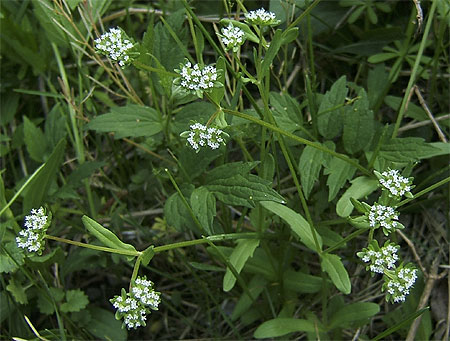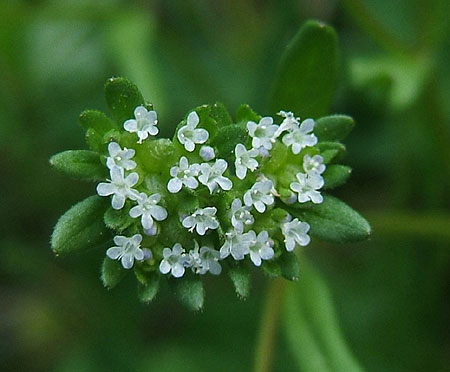 Corn Salad or Lamb's Lettuce
Corn Salad or Lamb's Lettuce
Valerianella locusta
Photos by Phil Lucas
From Missouri Plants
Stems - Multiple from the base, dichotomously branching, erect, to +20cm tall, herbaceous, from a single thin taproot and fibrous roots, retrorse pubescent, 4-angled. Internodes with shallow thin vertical grooves arising at the leaf bases.

Leaves - Basal leaves in a rosette, spatulate, to +8cm long, 2cm broad. entire, glabrous or with very sparse appressed pubescence, rounded at the apex. Cauline leaves opposite, sessile, lanceolate to lance-oblong, reduced upward, rounded at the apex, entire or with a few coarse basal teeth, glabrous.
Inflorescence - Terminal involucrate cymose clusters of flowers. Bracts of the involucre glabrous but strigose-ciliate on the apical margins, often reddish on the apical margins in strong sun, oblong, quite small in flower but quickly expanding to +/-3mm long, 1-1.5mm broad, 2 per each flower. Flowers sessile.
Flowers - Corolla light blue (typically) to whitish, funnelform, glabrous, 5-lobed. Corolla tube to 1mm long. Lobes spreading, rounded at the apex, .75mm long, .6mm broad. Stamens 2-3, adnate at the apex of the corolla tube, included to slightly exserted. Filaments glabrous, .8mm long, translucent-blue. Ovary inferior, 3-locular, green, expanded at the apex on one side, very sparse pubescent in flower, 1mm long in flower, quickly inflating in fruit to +2mm long.
Flowering - April - May.
Habitat - Waste ground, disturbed areas, borders of fields, roadsides.
Origin - Native to Europe.
Other info. - The plant is edible and is widely cultivated in Europe and elsewhere. It is not too common as a food crop in the United States.